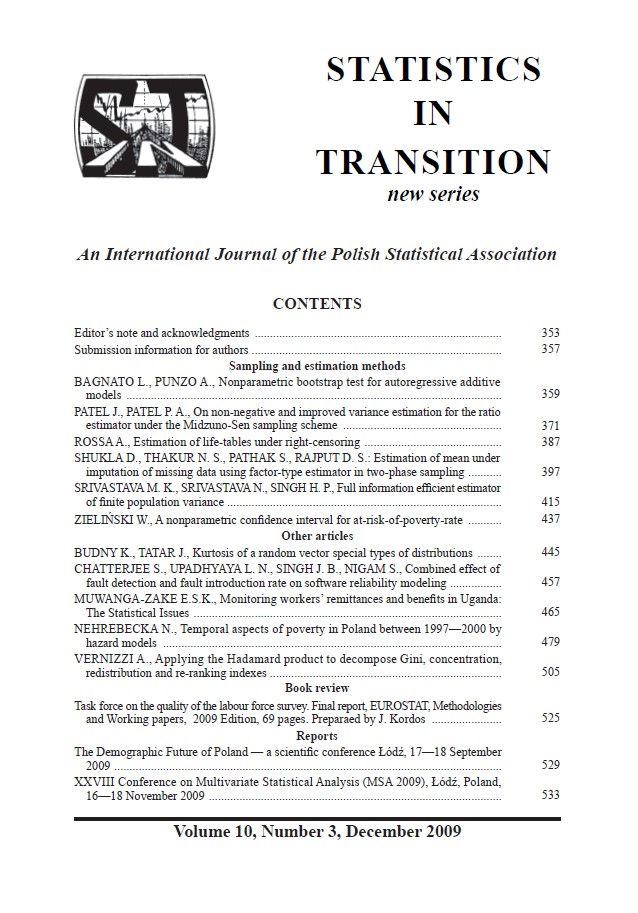ARTICLE
ABSTRACT
Gini and concentration indexes are well known useful tools in analysing redistribution and re-ranking effects of taxes with respect to a population of income earners. There are several attempts in the literature to decompose Gini and re-ranking indices to analyse potential redistribution effects and the unfairness of a tax systems, including ones that consider contiguous income groups being created by dividing the pre-tax income parade according to the same bandwidth. However, earners may be very often split into groups characterized by social and demographic aspects or by other characteristics: in these circumstances groups can easily overlap. In this paper we consider a more general situation that takes into account overlapping among groups; we obtain matrix compact forms for Gini and concentration indexes, and consequently, for redistribution and re-ranking indexes. In deriving formulae the so called matrix Hadamard product is extensively used. Matrix algebra allows to write indexes aligning incomes in a non decreasing order either with respect to post-tax income or to pre-tax incomes. Moreover, matrix compact formulae allow an original discussion for the signs of the within group, across group, between and transvariation components into which the Atkinson-Plotnick-Kakwany reranking index can split.
KEYWORDS
Gini and concentration indexes decompositions, Tax redistributive effects, Tax re-ranking effects, Hadamard product.
REFERENCES
ARONSON R. J., P. J. LAMBERT (1993), “Inequality decomposition analysis and the Gini coefficient revisited”, The Economic Journal, 103, pp. 1221– 1227.
ARONSON R. J., P. J. LAMBERT (1994), “Decomposing the Gini coefficient to reveal the vertical, horizontal and re-ranking effects of income taxation”, National Tax Journal, 47, pp. 273–294.
ARONSON R. J., P. J. JOHNSON, P. J. LAMBERT (1994), “Redistributive effect and unequal income tax treatment”, The Economic Journal, 104, pp. 262–270.
BHATTACHARYA, N., B. MAHALANOBIS (1967). “Regional disparities in household consumption in India”, Journal of the American Statistical Association, 62, pp. 143–161.
DAGUM C. (1997), “A new approach to the decomposition of Gini income inequality ratio”, Empirical Economics, 22, pp. 515–531.
FALIVA M. (1983), Identificazione e Stima nel Modello Lineare ad Equazioni Simultanee, Vita e Pensiero, Milano.
FALIVA M. (1987), Econometria, Principi e Metodi, UTET, Torino.
FALIVA M. (1996), “Hadamard matrix product, graph and system theories: motivations and role in Econometrics”, Matrices and Graphs, Theory and Applications to Economics, S. Camiz, S. Stefani eds., World Scientific, London.
FALIVA M. (2000), “Su alcune funzioni generalizzate utilizzate nell’analisi dei processi armonizzabili”, Statistica, 60, 4, pp.655–667.
KAKWANI N. C. (1980), Income Inequality and Poverty: Methods of Estimation and Policy Applications, Oxford University Press.
LAMBERT P. (2001), The Distribution and Redistribution of Income, Manchester University Press.
LANDENNA G. (1994), Fondamenti di Statistica Descrittiva, il Mulino, Bologna.
MONTI M., A. SANTORO (2007), “The Gini decomposition: an alternative formulation with an application to tax reform”, ECINEQ, 2nd Conference, Berlin, available at http://www.diw.de/documents/dokumentenarchiv/17/60106/papermonti_santoro.pdf.
MONTI, M. (2007), “On the Dagum decomposition of the Gini inequality index”, DEAS Universita degli studi di Milano, W.P. 2007–16.
MONTI M. (2008), “A note on the residual term R in the decomposition of the Gini Index”, Argumenta Oeconomica, 20, 1, pp. 107–138.
MOOKHERJEE, D., A. SHORROCK (1982). “A Decomposition Analysis of the Trend in UK Income Inequality”, The Economic Journal, 92, pp. 886–902.
MUSSINI M. (2008), La misurazione del riordinamento: aspetti metodologici ed un’applicazione con riguardo ai redditi delle famiglie milanesi, PhD thesis, Universita degli Studi di MIlano-Bicocca.
PLOTNICK R. (1981), “A measure of horizontal inequity”, Review of economics and Statistics, 63, 283–288.
PYATT, G. (1976). “On the Interpretation and desegregations of Gini Coefficient”, Economic Journal, v86, 243–255.
RAO, V. (1969). “The Decomposition of the Concentration ratio”, Journal of the Royal Statistical Society, 132, 418–25.
SCHOTT J. F. (2005), Matrix Analysis for Statistics, 2nd edition, Wiley, Hoboken, New Jersey.
SILBER, J.(1989). “Factor Components,Population Subgroups and the Computation of the Gini Index of Inequality”, The Review of Economics and Statistics, 71, 107–115.
URBAN I., P. J. LAMBERT, (2008), “Redistribution, horizontal inequity and reranking: how to measure them properly”, Public Finance Review, 20, n. 10, pp.1–24.
VERNIZZI A. (2007), “Una precisazione sulla scomposizione dell’indice di redistribuzione RE di Aronson-Johnson-Lambert e una proposta di estensione dell’indice di Plotnick”, Economia Pubblica, 37, n. 1–2, pp. 145–153, and DEAS, Universita degli Studi di Milano, WP 2006–28.
YITZAHAKI, S., R. LERMAN, (1991).”Income stratification and income inequality”, Review of income and wealth, 37, 313–329.
YITZAHAKI, S. (1994). “Economic distance and overlapping of distributions”, Journal of Econometrics,. 61, pp. 147–159.
